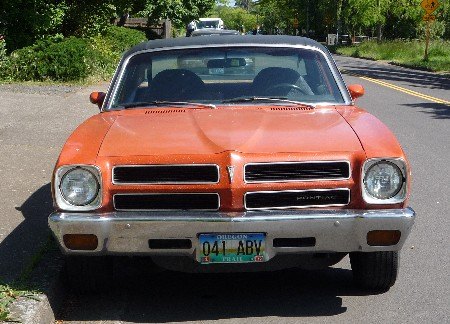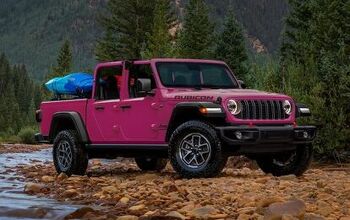Curbside Classics: GM's Deadly Sin #3 – 1971 Pontiac Ventura II

Bernie Madoff’s first bogus trade. Richard Nixon’s first fib. Charlie Parker’s first hit of heroin. What do they have in common with this perfectly harmless-looking Pontiac Ventura II? That first little giving in to temptation has a nasty way of turning into a big deadly habit, like GM’s badge engineering. All bad habits have a beginning, but the evidence typically is lost in the haze of history. Not GM’s. Before you sits the proof; the badge-engineering progenitor; the automotive equivalent of finding Humphrey Bogart’s first Lucky Strike butt laying at the curb.
I can’t tell you exactly the behind-the-scenes machinations that led to giving Pontiac a “grill engineered” version of Chevy’s popular Nova in the spring of 1971. But it cracked open a door that was eventually ripped off its hinges after the energy crisis of 1973. Every GM division then rushed through it and jumped into that bottomless cesspool without a second thought. Desperate for smaller cars, Oldsmobile, Buick and even Cadillac soon joined in with Pontiac. The attack of the Chevrolet body snatchers was on.
Presumably, Pontiac had misgivings at how large its Tempest and LeMans had grown from their 1961 compact origins. And by 1970, the continued growth in the small car sector was undeniable. Chevy was getting ready to launch its sub-compact Vega. Pontiac felt left out, and wanted back in. And they had a solution in hand and ready to roll, north of the border: the Acadian.
GM long had a pattern of doing things a little differently in Canada, especially with Pontiac. Canadian Ponchos were hybrids, of a different type. They used Chevrolet chassis, engines and transmission, but Pontiac exteriors. And bore different names too, like Laurentian and Parisienne. GM Canada was the prelude to the badge-engineering main act to come.
At the beginning of the sixties, Pontiac of Canada expected to either get the new 1961 Tempest or a version of the new Corvair as its compact. Instead, it got a grill-engineered version of the 1962 Chevy II, called Acadian. Strictly speaking, it wasn’t a Pontiac, but a separate low-end brand for Canadian Pontiac-Buick dealers to sell.
I remember well first stumbling across one as a kid in Iowa. I had earned an honorary degree in Autology by dint of my car-spotting abilities. But this one threw me; a mildly customized Chevy II? I eventually figured out the limitations of my US-centric viewpoint, and that Canadians must know what they were doing when it came to Chevy IIs and healthcare.
The Acadian was still going in 1971, so all Pontiac had to do was divert a stream of them southwards – or at least a few truckloads of grills. I don’t know where the Ventura II was actually assembled. But it was all Chevy, all the time, right down to the engines. Which marks this as the beginning of another bad habit: the first GM (NA) car with all of its engines from another division: Chevy’s 250 six and 307/350 V8s were on offer in the abbreviated first year. By 1972, the Pontiac 350 V8 was also in the mix. And a couple of years later, the vaunted letters GTO were gracing this Nova clone. Who saw that coming?
End of story. I’m not going talk about this Ventura per se, because I have several real Novas in the can for future Curbside Classics. It’s not like there’s any difference. But I am going to save some equal time for the other Nova-based clones: Apollo, Omega, Phoenix and Skylark; the whole family of dirty little habits.

More by Paul Niedermeyer
Latest Car Reviews
Read moreLatest Product Reviews
Read moreRecent Comments
- ToolGuy I might be Batman.
- Lou_BC Well, I'd be impressed if this was in a ZR2. LOL
- Lou_BC This is my shocked face 😲 Hope formatting doesn't fook this up LOL
- Lou_BC Junior? Would that be a Beta Romeo?
- Lou_BC Gotta fix that formatting problem. What a pile of bullsh!t. Are longer posts costing TTAC money? FOOK





































Comments
Join the conversation
Though the Ventura II (What happened to the Ventura I?) might have been the first GM model to offer only another division's engines, it should be noted that when GM introduced their compacts in 1961 the Buick Special, Olds F-85, and Pontiac Tempest all shared the 215 cubic inch V8 (Though most Tempests came equipped with the standard "half a 389" 4 cylinder, the 215 was an option). As to where the Ventura (and its badge-engineered counterparts) were assembled, from reading the Standard Catalog books for each division and decoding the VIN numbers of cars I've seen for sale, most were made in either Willow Run (In Ypsilanti, MI, where I think most, if not all, Corvairs were made), Van Nuys, CA, or North Tarrytown, NY. Through it's lifespan and even after it morphed into the Phoenix, the Ventura continued to offer only other divisions engines. The Chevy 250 six was eventually replaced by the Buick 231 V6 as the standard engine with the Olds 260 V8, Chevy 305, and Buick 350 as options at one time or another. The Skylark did eventually surface as a badge engineered X-body (Nova) in 1975. In 1973, Buick revived the Century name for its intermediates and the Apollo was their Nova clone. In 1975, the two-door models were Skylarks and the 4-doors were Apollos. In 1976, all body styles became Skylarks.
They all did this in the 70's onwards. Who can forget the Ford Granada, Mercury Monarch and the Lincoln Versailles, three pees in a pod. Things were vastly different back in those days. When something was selling well the answer was to clone the heck out of it with another name and watch the sales climb up. Even vacuum cleaner companies were doing this. Hoovers were being sold to Wards, Western Auto, Pennys and Eatons under alias names and color combinations but were the same thing underneath. Remember the Regina Electrikbroom in the 60's-80's. Well Sears, Pennys, Singer, Eatons and Iona also sold the same thing with there name on it sporting different color schemes and badges, sort of like the cars themselves in this article.